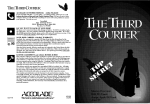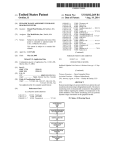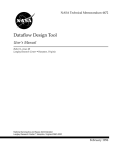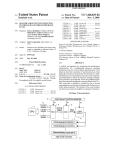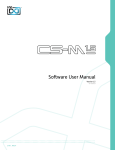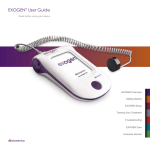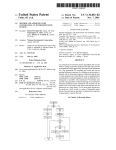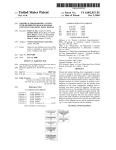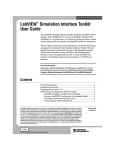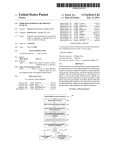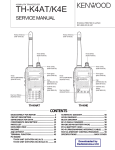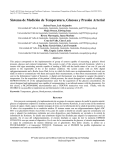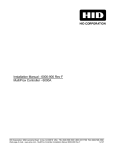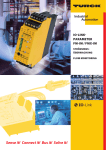Download Automatically configuring a graphical user interface element to bind
Transcript
US007624375B2 (12) United States Patent (10) Patent N0.: (45) Date of Patent: Santori et a]. (54) AUTOMATICALLY CONFIGURING A GRAPHICAL USER INTERFACE ELEMENT TO BIND TO A GRAPHICAL PROGRAM US 7,624,375 B2 Nov. 24, 2009 5,861,882 A 1/1999 Sprenger et a1. 5,870,746 A * 2/1999 Knutson et al. ........... .. 707/101 (Continued) (75) Inventors: Michael L. Santori, Austin, TX (US); FOREIGN PATENT DOCUMENTS John C. Limroth, Austin, TX (US); Gregory O. MorroW, Austin, TX (US) EP 0398646 A2 11/1990 (Continued) (73) Assignee: National Instruments Corporation, OTHER PUBLICATIONS Austin, TX (US) Notice: Subject to any disclaimer, the term of this patent is extended or adjusted under 35 “LabVIEW Simulation Interface Toolkit”, National Instruments Corp., Oct. 2002, 9 pages. Online retrieved at <http://www.ni.com/ pdf/manuals/370420a.pdf>.* U.S.C. 154(b) by 830 days. (Continued) Primary ExamineriTuan Q Dam Assistant ExamineriThuy Dao (74) Attorney, Agent, or FirmiMeyertons Hood Kivlin Kowert & GoetZel, P.C.; Jeffrey C. Hood; Mark S. Williams (21) Appl. N0.: 10/460,147 (22) Filed: Jun. 12, 2003 (65) Prior Publication Data US 2004/0255269 A1 (51) (57) Dec. 16, 2004 ABSTRACT System and methods for con?guring communication Int. Cl. G06F 9/44 G06F 3/048 between a graphical program element (GPE) and a graphical user interface element (GUIE), where the GPE and the GUIE (2006.01) (2006.01) are from different respective graphical program development environments. In response to receiving user input specifying (52) US. Cl. ..................... .. 717/121; 717/105; 715/717; (58) Field of Classi?cation Search ..................... .. None the GPE and GUIE, and a data source/data target association between them, at least one of the GUIE and the GPE are See application ?le for complete search history. programmatically modi?ed to con?gure communication References Cited between the GPE and the GUIE. The graphical program is then executed, where either the GPE performs a function to 715/763 (56) U.S. PATENT DOCUMENTS 5,163,130 5,475,851 5,481,741 5,553,223 5,801,942 5,825,361 5,828,851 5,838,593 11/1992 12/1995 1/1996 9/1996 9/1998 10/1998 10/1998 11/1998 Hullot Kodosky et al. McKaskle et al. Greenlee et al. Nixon et al. Rubin et al. Nixon et al. Komatsu et a1. generate data, provides the data to the GUIE, and the GUIE displays the received data; or, the GUIE element receives data from the user, provides the data to the GPE, and the GPE receives the data and performs a function based on the data. The user input may be performed via drag-and-drop user interface technique, line-drawing, command-line, menu, dia log box, or wizard, etc. 40 Claims, 10 Drawing Sheets Receive user input specifying an association between a graphical program element and a GUI element 200 In response to the user input, automatically configure the graphical program element and the GUI element to interface during program execution 20_2 US 7,624,375 B2 Page 2 US. PATENT DOCUMENTS 5,966,532 A * 10/1999 McDonald et al. ........ .. 717/105 6,076,952 A 6,078,320 A 6/2000 Gretta et al. 6/2000 Dove et al. 6,102,965 A 8/2000 Dye et al. 6,173,438 B1 6,219,628 B1 1/2001 Kodoskyetal. 4/2001 Kodoskyetal. 6,262,729 B1 7/2001 Marcos et al. 6,370,569 B1* 4/2002 6,374,308 B1 4/2002 Kempfet al. Austin ...................... .. 709/217 6,496,205 B1 12/2002 White et al. 7,134,085 B2* 7,210,117 B2* 11/2006 4/2007 2001/0020291 A1* Austin ...................... .. 715/763 Kudukoliet a1. .. . 717/100 9/2001 Kudukoliet a1. 2001/0034879 A1* 10/2001 Washington et al. 2001/0034881 A1* 10/2001 2001/0045963 A1 2002/0070965 A1 11/2001 Marcos et al. 6/2002 Austin 717/1 . 717/1 Washington ................. .. 717/5 2002/0089538 A1* 7/2002 WenZel et a1. ............. .. 345/763 2002/0101449 A1 8/2002 Friskel 2004/0158812 A1* 8/2004 Dye et al. ................. .. 717/105 FOREIGN PATENT DOCUMENTS EP EP WO WO W0 0 803 809 0803809 A2 94/10627 94/15311 W0 03/005337 10/1997 10/1997 5/1994 7/1994 1/2003 OTHER PUBLICATIONS R.S.D. Wahidanabanu, M.A. Panneer Selvam and K. Udaya Kumar; “Virtual Instrumentation with Graphical Programming for Enhanced Detection and Monitoring of Partial Discharges”, Proceedings of the Electrical Insulation Conference; Sep. 1997; pp. 291-296. H.J.W. Spoelder, A.H. Ullings and F.C.A. Groen; “Virtual Instrumen tation: A Survey of Standards and their Interrelation”, Proceedings of IEEE Instrumentation and Measurement Technology Conference; May 1997; pp. 676-681; vol. 1. Luc De Coster; “Grape-II”; Automatic Control and Computer Archi tectures Department. Katholieke Universiteit Leuven, Belgium, Feb. 22, 1996 [retrieved Oct. 6, 1999] Retrieved from the Internet @ http://www.esat.kuleuven.ac.be/acca; 25 pages. Sujatha Srinivasan, M. BodruZZaman, A. Shirkhodaie and M. Malkani; “LabVIEW Program Design for on-line Data Acquisition and Predictive Maintenance”, Proceedings of the 30th Southeastern Symposium on System Theory, Mar. 1998; pp. 520-524. Jose Luis Pino, Michael C. Williamson and Edward A. Lee; “Inter face Synthesis in Heterogeneous System-Level DSP Design Tools”; IEEE International Conference on Acoustics, Speech, and Signal Processing; May 1996; 4 pages. Shuvra Bhattacharyya, et al.; The Almagest, vol. liPtolemy 0.7 User’s Manual; Regents of the University of California; 1990-1997; pp. 1-1 through 5-51 (175 pages). Shuvra Bhattacharyya, et al.; The Almagest, vol. liPtolemy 0.7 User’s Manual; Regents of the University of California; 1990-1997; pp. 5-52 through 15-7 (176 pages). Shuvra Bhattacharyya, et al.; The Almagest, vol. liPtolemy 0.7 User’s Manual; Regents of the University of California; 1990-1997; pp. 15-8 through I-24 (181 pages). Edward A. Lee; “Design Methodology for DSP”; 1992; 4 pages. Edward Ashford Lee, Edwin Goei, Jeff Bier and Shuvra Bhat tacharyya; “A Design Tool for Hardware and Software for Multipro “LabVIEW Simulation Interface Toolkit”, National Instruments Corp., Oct. 2003, 37 pages. Online retrieved at <www.ni.com/pdf/ cessor DSP Systems”; May 1989; 4 pages. “Gabriel 0.7 Overview”, 1990, 5 pages. manuals/370420b.pdf>.* Asawaree Kalavade and Edward A. Lee; “Hardware/ Software Co International search report and written opinion application No. PCT/ Design Using PtolemyiA Case Study”; Proceedings of the First US2004/019018 mailed Nov. 29, 2005. International Workshop on Hardware/ Software Codesign; Sep. 1992; www.mathworks.com “Real-Time Workshop 4 for generating opti miZed, portable, and customizable code from Simulink models,” Oct. 2000, 6 pages. The Measurement and Automation Catalog 2001 National Instru ments Corporation, Copyright 2000, pp. 100 and 101. “Dynamic System Simulation for MATLAB” Using Simulink, Ver sion 4, Copyright 1990-2000 by The MathWorks, Inc., pp. 1-2 through 3-28. LabVIEW User Manual, Chapter 7 “Creating Vis and SubVIs,” 2000, pp. 7-1 through 7-12 and II-1 through II-2. 18 pages. Jose Luis Pino; “Software Synthesis for Single-Processor DSP Sys tems Using Ptolemy”; Master’s Report; May 1993; 48 pages. Jose Luis Pino, Soonhoi Ha, Edward A. Lee and Joseph T. Buck; “Software Synthesis for DSP Using Ptolemy”; Journal ofVLSI Sig nal Processing; 1995; 15 pages. Jose Luis Pino, Thomas M. Parks and Edward A. Lee; “Mapping Multiple Independent Synchronous data?ow Graphs onto Hetero ge neous Multiprocessors”; 28th Annual Asilomer Conference on Sig nals, Systems, and Computers; Oct. 1994; 6 pages. “Solutions for Control” Catalog 1999, dSPACE, Copyright 1998 Jose Luis Pino, Thomas M. Parks and Edward A. Lee; “Automatic dSPACE GmbH; pp. 1-168. Code Generation for Heterogeneous Multiprocessors”; ICASSP; Marleen Ade, Rudy Lauwereins, and J .A. Peperstraete; “Hardware Software Codesign with Grape”; Katholieke Universiteit Leuven, Belgium, pp. 40-47. Rudy Lauwereins, Marc Engels, Marleen Ade and J. A. Peperstraete; “Grape-II: A System-Level Prototyping Environment for DSP Appli cations”; Feb. 1995; pp. 35-43; Katholieke Universiteit Leuven, Bel 1994; 4 pages. Asawaree Kalavade and Edward A. Lee; “A Hardware-Software gium. X.-P. Ling and H. Amano; “WASMII: a Data Driven Computer on a Virtual Hardware”; IEEE 1993, pp. 33-42. A. Takayama, Y. Shibata, K. Iwai, H. MiyaZaki and X. -P. Ling; “Implementation and Evaluation of the Compiler for WASMII, a Virtual Hardware System,” 6 pages. Alan Wenban and Geoffrey Brown; “A Software Development Sys tem for FPGA-based Data Acquisition Systems”; Proceedings of the IEEE Symposium on FPGAs for Custom Computing Machines; Apr. 1996; pp. 28-37. “Lookout Developer’s Manual”; Aug. 1999 Edition; National Instru ments Corporation; Austin, Texas. Edward Lee, Edwin Goei, Holly Heine, Wai Ho, Shuvra Bhat tacharyya, Jeff Bier and Erik Guntvedt; “Gabriel: A Design Environ Codesign Methodology for DSP Applications”; IEEE Design and Test ofComputers; Sep. 1993; pp. 16-28. Ashok Bindra; “Tool Chest continues to Grow”; Electronic Engineer ing Times; Dec. 15, 1995; 2 pages. “SPWiMatLAB Co-Simulation InterfaceiIntegrates Matlab a1 go rithms into SPW designs through seamless co-simulation and ?le sharing”; Product Data Sheet; 1996; 2 pages. “6. The Alta Group of Cadence Design Systems, Inc. Signal Process ing Worksystem (SPW)”; 1995; 34 pages; Berkeley Design Technol ogy Inc. “Signal Processing WorkSystemiMatLAB Interface User’s Guide”; Alta Group of Cadence Design Systems, Inc.; 1995; 72 pages. “Choosing Block-Diagram Tools for DSP Design”; DSP & Multi media Technology; Apr. 1995; 7 pages; retrieved from the Internet: http://www.bdti.com/articles/infoidspmt95blockdiagram.htm. Speech, and Signal Processing; Nov. 1989; pp. 1751-1762; vol. 37, “Xanalog Specializing in Workstations for Continuous Dynamic Simulation”; Presentation; 1987; 24 pages. “Real-Time User Guide”; 1994; 28 pages.; Xanalog Corporation. “Xanalog/ RT Real Time Analog and Digital I/O”; Oct. 1990; 4 pages; No. 11. Xanalog Corporation. ment for Programmable DSPs”; IEEE Transactions on Acoustics, US 7,624,375 B2 Page 3 “The dSpace Real-Time Interface to Simulink for PC”; 1995; 118 Miriam Leeser, Richard Chapman, Mark Aagaard, Mark Linderman and Stephan Meier; “High Level Synthesis and Generating FPGAs pages; dSpace. “Guide to Rapid Prototyping with Simulink, Real-Time Workshop with the BEDROC System”; Journal of VLSI Signal Processing; and dSPACE”; 1995; 16 pages; The Math Works. Kevin J. Gorman and Kouro sh J. Rahnamai; “Real-Time Data Acqui Christian Boulay, Michel Lafortune, and Robert Guardo; “A High sition and Controls Using MatLAB”; Proceedings of the Computers in Engineering Conference and the Engineering Database Sympo sium; 1995; 4 pages. Real-Time Workshop, for Use with Simulink, User’s Guide, May 1994, pp. 1-1 through 6-6 (115 pages). Real-Time Workshop, for Use with Simulink, User’s Guide, May 1994, pp. 6-7 through Index-6 (115 pages). Joseph T. Buck and Edward A. Lee; “Scheduling Dynamic Data?ow Graphs with Bounded Memory Using the Token Flow Model”; Insti tute of Electrical and Electronics Engineers; Apr. 1993; 4 pages. “Statemate/C” Product Overview; 1995; 4 pages; i-Logix. “i-Logix Signs Reseller Agreement for Virtual Prototypes, Inc.’s VAPS Product Line”; Press Release; Feb. 11, 1997; 2 pages. 1993; pp. 191-214. Throughput Controller for a 256-channel Cardiac Potential Mapping System”; Canadian Conference on Electrical and Computer Engi neering; Sep. 1995; pp. 539-542; vol. 1. Patrick Lysaght and Jon Stockwood; “A Simulation Tool for Dynami cally Recon?gurable Field Programmable Gate Arrays”; IEEE Transactions on Very Large Scale Integration (VLSI) Systems; Sep. 1996; pp. 381-390; vol. 4, No. 3. Michael Petronino, Ray Bambha, James Carswell and Wayne Burleson; “An FPGA-based data acquisition system for a 95 GHZ W-band radar”; IEEE International Conference on Acoustics, Speech, and Signal Processing; Apr. 1997; pp. 4105-4108. Rudy Lauwereins, Marc Engles and J. A. Peperstraete; “Grape-II: A System-Level Prototyping Environment for DSP Applications”; Feb. “i-Logix Introduces Rhapsody, Obj ect-Oriented analysis, Design and 1995; Katholieke Universiteit; Leuven, Belgium. Implementation Tool”; Press Release; Feb. 10, 1997; 2 pages. “i-Logix and Integrated Systems Link Statemate Magnum and Matrix AutoCode”; Press Release; Jan. 3, 1997; 2 pages. “i-Logix and Wind River unveil Industry’s First Rapid Prototyping “VisSim/TI C2000 Rapid Prototyper Version 4.5”; 2000; 158 pages; Third edition; Visual Solutions, Inc. “VisSim/C-Code 4.0 Automatic C Code Generation Software”; 1 page; Visual Solutions, Inc. Solution for Testing Embedded Systems at ESC West in San Jose”; Arun Mulpur; “VisSim/CommDSP Rapid Prototyping Software: Sep. 17, 1996, 3 pages. “Express-Statemate Product Family”; 1995; 6 pages; i-Logix, Inc. “Statemate Technical Overview-Systems Design Automation For Reactive Systems”; 1996; 14 pages; i-Logix, Inc. “Statemate Magnum Technical Overview-Systems Design Auto mation for Complex Systems”; 1996; 18 pages; i-Logix, Inc. “Xanalog’s CAE System: The Fastest AT Alive”; Mass High Tech; Aug. 1986; vol. 4, No. 22; 1 page. “Xanalog Corporation Sales Manual”; Jan. 1987; 8 pages; Xanalog Communication System to TI DSPs”; 20 pages;Visual Solutions, Inc. Professional VisSim 4.0 Dynamic Modeling and Simulation Soft Corporation; Woburn, MA. ware; 3 pages; Visual Solutions, Inc. Arun Mulpur; “VisSim/CommDSP Rapid Prototyping Software: Communication System to TI DSPs”; 20 pages;Visual Solutions, Inc. Inc. “VisSim Embedded Controls Developer A Smarter, Faster Way for Embedded Control Design”; 2 pages; Visual Solutions, Inc. Edward A. Lee; “Overview ofthe Ptolemy Project”; Feb. 1, 1999; 14 “Available XA-1000 Literature and Its Use”; Jan. 1987; 2 pages. pages; Department of Electrical Engineering and Computer Science, University of California; Berkeley, CA. “Industry News”; Simulation; vol. 47, No. 1, Jul. 1986, 3 pages. “XA-1000 Programming ICONS”; 1986; 15 pages; Xanalog. “XA-1000 Programming Examples”; technical data; 6 pages; Jon Davis, II, et al.; “-Ptolemy II- Heterogeneous Concurrent Mod eling and Design in JAV ”; Feb. 12,1999; 124 pages; Department of Electrical Engineering and Computer Science, University of Califor Xanalog. nia; Berkeley, CA. Real-Time Workshop Getting Started; Jul. 2002; 96 pages; Version 5; The MathWorks, Inc.; Natick, MA. “Quick quali?cation and pitching of the XA-1000”; Nov. 1986; 4 pages; Xanalog Corporation. “MultiProx for SPW-Graphical multiprocessor environment for DSP algorithm development and implementation”; Product Data Sheet; Aug. 1994; 4 pages; The Alta Group of Cadence Design Systems, Inc. “DSP ProCoder for SPW-Translates SPW signal-?ow block dia grams into highly optimized source code for ?xed point DSP proces sors”; Product Data Sheet; Nov. 1994; 4 pages; The Alta Group of Cadence Design Systems, Inc. “Code Generation System (CGS)iAutomatic C Code generator for SPW accelerates simulation and enables rapid prototyping of DSP systems”; Product Data Sheet; 1994; 8 pages; The Alta Group of Cadence Design Systems, Inc. “SPW/CGS Porting Kits4Complete software package for interfac ing the Code Generation System to any processor chip or develop ment board”; Product Data Sheet; Nov. 1994; 2 pages; The Alta Group of Cadence Design Systems, Inc. Jeffrey C. Bier, Edwin E. Goei, Wai H. Ho, Philip D. Lapsley, Maureen P. O’Reilly, Gilbert C. Sih and EdwardA. Lee; “Gabriel: A Design Environment for DSP”; IEEE Micro Oct. 1990; pp. 28-45; vol. 10, No. 5. Edward A. Lee, Wai-Hung Ho, Edwing E. Goei, Jeffrey C. Bier and Shuvra Bhattacharyya; “Gabriel: A Design Environment for Pro grammable DSPs”; IEEE Transactions on Acoustics, Speech, and Signal Processing; Nov. 1989, pp. 1751-1762; vol. 37, No. 11. “i-Logix Statemate Magnum Supports PCs”; Press Release; Jan. 31, 1997; 2 pages. “Xanalog/SC+”; Sep. 1990; 4 pages; Xanalog Corporation; Woburn, MA. MD. Edwards and J. Forrest; “Software acceleration using program mable hardware devices”; IEE Proceedings Computers and Digital Techniques; Jan. 1996; pp. 55-63; vol. 143, No. 1. Real-Time Workshop User’s Guide; Jul. 2002; pp. 1-5-59; Version 5; The MathWorks, Inc.; Natick, MA. Real-Time Workshop User’s Guide; Jul. 2002; pp. 5-60 through 12-14; Version 5; The MathWorks, Inc.; Natick, MA. Real-Time Workshop User’s Guide; Jul. 2002; pp. 12-15 through 1-7; Version 5; the MathWorks, Inc.; Natick, MA. Real-Time Windows Target User’s Guide-For Use with Real-Time Workshop; Sep. 2000; 178 pages; Version 2; The MathWorks, Inc.; Natick, MA. Simulink ReferenceiModel-Based and System-Based Design; Jul. 2002; pp. 1 through 2-162; Version 5; The MathWorks, Inc.; Natick, MA. Simulink ReferenceiModel-Based and System-Based Design; Jul. 2002; pp. 2-163 through 2-354; Version 5; The MathWorks, Inc.; Natick, MA. Simulink ReferenceiModel-Based and System-Based Design; Jul. 2002; pp. 2-355 through I-12; Version 5; The MathWorks, Inc.; Natick, MA. xPC Target Getting Started; Jul. 2002; 163 pages; Version 2; The MathWorks, Inc.; Natick, MA. xPC Target User’s Guide; Jul. 2002; 196 pages; Version 2; The MathWorks, Inc.; Natick, MA. xPC Targetbox User’s Guide; Nov. 2002; 136 pages; Version 2; The MathWorks, Inc.; Natick, MA. MATRiXx Systembuild User’s Guide, 7.0; Nov. 22, 2000; pp. 1-166; Wind River Systems, Inc.; Alameda, CA. MATRiXx Systembuild User’s Guide, 7.0; Nov. 22, 2000; pp. 167 360; Wind River Systems, Inc.; Alameda, CA. MATRiXx Systembuild User’s Guide, 7.0; Nov. 22, 2000; pp. 361 550; Wind River Systems, Inc.; Alameda, CA. * cited by examiner US. Patent Nov. 24, 2009 Sheet 1 0f 10 US 7,624,375 B2 HCSoymsputemr ‘I02 F1igure US. Patent Nov. 24, 2009 WU Sheet 2 0f 10 ES2Q9O6 om 8ES2Q9O$ Now US 7,624,375 B2 US. Patent Nov. 24, 2009 5$5. 3 2 8m32 Sheet 3 0f 10 #3 US 7,624,375 B2 mm? 52 32 .2:2 8 8%?235 wEm? $2.695E5 omC6?2:6520 US. Patent Nov. 24, 2009 Sheet 5 0f 10 US 7,624,375 B2 Computer FIG.4 Network DAQwBoiatrhd Proces r 14 1 Stimuls US. Patent Nov. 24, 2009 Sheet 6 0f 10 US 7,624,375 B2 Receive user input specifying an association between a graphical program element and a GUI element 200 V In response to the user input, automatically configure the graphical program element and the GUI element to interface during program execution 20_2 FIG. 5 I Step 200 l Display a user interface dialog box for specifying data connection information E V Developer chooses a "Subscribe", "Publish", or "Publish and Subscribe" option for the data connection type 252 I Developer optionally specifies the graphical program element and/or the GUI element as data source or target respectively, e.g., via DataSocket, etc. 335 I Developer applies information specified via dialog box 256 FIG. 6 US. Patent Nov. 24, 2009 Sheet 8 0f 10 US 7,624,375 B2 wuEmwcnm w-IUI +521E. 25:. 72.? 2E39i “min60H g03:52 ; 2:95 3.53 2: 5 hum w US. Patent Nov. 24, 2009 Sheet 9 0f 10 US 7,624,375 B2 DataSocket Connection Connect To: lserverl F g El 1 1M‘ ,5 a W -,- Connection Type We.” M ,. C.“ Wt... -... H... w r 7 f7 7. WWW.“ . M. .MMM- 5Ul35Ull3'B Attach Browse... I ,- . Only enabled connections publish andi‘or (‘-2. Publish and Subscribe 5 m. M: . Remove subscribe datawhen 'i-‘I runs. l l Cancel lijbataSocket Connection Mesh" 1 ‘Co Connect To: mm" lFf'lVer li i MMM . Connection , Subscribe . Type -. . . . 1 Publish and Subscribe Attach W W w Remove 1 FIG. 8B i l Browse... i?iEnabled subscribe Only enabled dataconnections when 'iI'I runs. publish andi'or i -C. 1 1. US. Patent Nov. 24, 2009 Sheet 10 0f 10 ¢ Throttle ' ? Crank spa d 1 F44 m Angle 6F attack a: Pilot G-Fsrce , Ehgine Contrclller ,1; Engine Speed ‘1 i Waveihrm Chant FIG. 9 US 7,624,375 B2 US 7,624,375 B2 1 2 AUTOMATICALLY CONFIGURING A GRAPHICAL USER INTERFACE ELEMENT TO BIND TO A GRAPHICAL PROGRAM element, Wherein the individual WindoWs may optionally be tiled together. When the controls and indicators are created in the front panel, corresponding icons or terminals may be automatically created in the block diagram by the block dia gram editor. Alternatively, the user can place terminal icons in the block diagram Which may cause the display of corre FIELD OF THE INVENTION sponding front panel objects in the front panel, either at edit The present invention relates to the ?eld of graphical pro gramming, and more particularly to a system and method for creating an association betWeen a graphical user interface element and a graphical program, e.g., a block diagram, Wherein the GUI element can provide data to and/or receive time or later at run time. As another example, the user inter face objects or front panel objects may be comprised in or embedded in the graphical program or block diagram. Thus, graphical programming has become a poWerful tool available to programmers. Graphical programming environ data from the graphical program. DESCRIPTION OF THE RELATED ART ments such as the National Instruments LabVIEW product have become very popular. Tools such as LabVIEW have Traditionally, high level text-based programming lan guages have beenused by programmers in Writing application programs. Many different high level programming languages greatly increased the productivity of programmers, and increasing numbers of programmers are using graphical pro gramming environments to develop their softWare applica tions. In particular, graphical programming tools are being exist, including BASIC, C, C++, Java, FORTRAN, Pascal, COBOL, ADA, APL, etc. Programs Written in these high level languages are translated to the machine language level by used for test and measurement, data acquisition, process con 20 data acquisition (SCADA) applications, product design, translators knoWn as compilers or interpreters. The high level programming languages in this level, as Well as the assembly modeling, simulation, and machine vision applications, among others. language level, are referred to herein as text-based program ming environments. Increasingly, computers are required to be used and pro grammed by those Who are not highly trained in computer programming techniques. When traditional text-based pro gramming environments are used, the user’s programming skills and ability to interact With the computer system often become a limiting factor in the achievement of optimal utili Zation of the computer system. More recently, a number of graphical program develop ment environments have been developed Which enable users to create graphical programs, also referred to as block dia grams. A graphical program may be de?ned as a program Which includes graphical code, Wherein the graphical code comprises a plurality of interconnected nodes Which visually indicate the functionality of the graphical program. Exem plary graphical program development environments include As noted above, a number of graphical program develop 25 ment environments have been developed Which enable users to create graphical programs. Certain graphical program 30 development environments have different capabilities. In addition, certain graphical program development envi ronments have varying types of functionality. For example, the LabVIEW graphical program development environment includes a rich graphical user interface capability Which enables users to create custom user interfaces or front panels for a graphical program. Other graphical program develop ment environments may lack a mature graphical user inter 35 face capability. Therefore, it Would be desirable to alloW users to utiliZe functionality from different graphical program development environments. More speci?cally, it Would be desirable to alloW users to utiliZe the graphical user interface elements from a ?rst graphical program development envi 40 LabVIEW from National Instruments, Simulink from The MathWorks, VEE from Agilent, Ptolemy, and numerous oth ers. Graphical programs may be created for virtual instrumen ronment With graphical programs or block diagrams of a second graphical program development environment. In many applications, data received from a data source or tation systems, industrial automation systems, modeling pro cesses, and simulation, as Well as for any type of general trol, man machine interface (MMI), supervisory control and 45 programming. provided to a data target may be associated With a graphical user interface (GUI) element. Graphical user interfaces (GUI s) enable users to interact With computer programs in an intuitive manner, utiliZing various types of GUI elements. Different graphical programming environments may enable During creation of a graphical program, the user may select various function nodes or icons that accomplish his desired the function nodes may be connected in one or more of a data 50 developers to include any of various types of GUI elements in a graphical program’ s graphical user interface or front panel. For example, GUI elements that may be used in instrumen How, control How, and/or execution ?oW format. Thus the tation or measurement applications may include a knob GUI user may create or assemble a graphical program, referred to element for adjusting a parameter, e.g., the frequency of a simulated signal, a chart GUI element for displaying a chart, result and connect the function nodes together. For example, as a block diagram, graphically representing the desired pro cess or system. The assembled graphical program may then be compiled or interpreted to produce machine language that e.g., of a poWer spectrum, a thermometer, an LED, a meter, a 55 accomplishes the desired method or process as shoWn in the block diagram. A user may also typically create a graphical user interface (GUI) or front panel for a graphical program. The graphical user interface or front panel may include various user inter face elements or front panel objects, such as controls or indi 60 Waveform chart, a tank, etc. Other types of GUI elements that may be included in a graphical user interface or front panel include text boxes, check boxes, etc. GUI elements may be con?gured to indicate data to the user, e.g., by displaying the data on a display screen. GUI elements may also be con?gured to provide user input to a graphical program. For example, When the value of a fre cators, that represent or display the respective input, output, quency knob on a user interface panel changes, e.g., due to a and/ or parameters that Will be used by the graphical program, and may include other icons Which represent devices being controlled. The front panel may be comprised in a single user interactively turning the knob, the graphical program may detect this change in value, e.g., by intercepting an event triggered When the value changes, and may respond by changing the signal that is generated in accordance With the WindoW of user interface elements, or may comprise a plu rality of individual WindoWs each having a user interface 65 neW frequency value. US 7,624,375 B2 3 4 As described above, in many cases, it may be desirable for data indicated by a GUI element to originate from a data gram (or graphical program element). In response to receiv ing user input (e.g., input received from a developer of the graphical program) creating the association betWeen the GUI element and the graphical program element, the graphical source outside of the graphical program, such as a ?le, server, or other data source. Also, in many cases, it may be desirable for data associated With a GUI element to be provided to a program element and/or the GUI element may be automati cally, i.e., programmatically, con?gured to communicate data and/or interoperate during program execution. Thus, When data target outside of the graphical program. For example, a graphical program to control a system located in a remote laboratory may have a graphical user interface panel includ ing various GUI elements such as knobs, buttons, etc. When a user changes the values associated With the GUI elements, it may be desirable for the graphical program to send the the graphical program executes, the GUI element may oper ate to provide data to and/or receive data from the graphical program element. In creating an association betWeen a graphical program element of the graphical program created in the second graphical program development environment and a GUI ele ment from the ?rst graphical program development environ values to a program running on a computer system in the remote laboratory Which is operable to send control signals to the system, based on the received GUI element values. Therefore, it Would also be desirable to provide a system ment, the user may begin by selecting either the graphical and method to simplify data exchange for a graphical pro program element or the GUI element ?rst. In one embodiment, the user selects a GUI element from gram, Wherein the data is associated With a GUI element. For example, it Would be desirable to provide a method for easily the ?rst graphical program development environment, e.g., enabling a GUI element to subscribe to data from a data source or publish data to a data target, Wherein the data source by right clicking on the GUI element. The user may then select a graphical program element in the graphical program or data target may be another graphical program. In some prior art systems, in con?guring a GUI element of a graphical program, a developer typically ?rst includes the GUI element in the graphical program’s user interface and then con?gures the GUI element to interface With a data source or data target. According to this methodology, the developer is required to ?rst select an appropriate GUI ele 20 (created in the second graphical program development envi ronment) With Which to associate the GUI element. Selection of the graphical program element may involve the user select ing the graphical program element in the graphical program 25 When the user selects the GUI element and selects an asso ciation option, the graphical program may be automatically displayed, and the user may then select the graphical program ment for the data source or data target, Which, to a certain extent, places the focus of the program development process on the GUI element itself. To enable a more natural develop ment process, it Would be desirable to provide a method that 30 that data source or target Would be automatically included in 35 For example, When the user selects the GUI element and selects an association option, the graphical program may be automatically displayed, and the user may then drag and drop the GUI element proximate to (or onto) the graphical program subscribe to data from or publish data to the data source or data target, respectively. element in the graphical program to create the association (or vice versa, i.e., the user could drag and drop the graphical As described above, the task of con?guring a program to exchange data With a data source or target can be dif?cult and time-consuming, and some users may not possess the neces element in the graphical program. Alternatively, selection of the graphical program element may involve the user graphi cally associating the GUI element With the graphical program element (e.g., by dragging and dropping one or both of the elements, draWing a “Wire” betWeen the tWo elements, etc.). alloWs the developer to specify the data source or data target of interest, and in response, a GUI element appropriate for the program’s user interface and automatically con?gured to using a pointing device to create the association. For example, 40 program element onto the GUI element to create the as socia sary knowledge required, especially those users Who are not tion). highly trained in programming techniques. Thus, it Would be out requiring the user to specify or Write any source code. For example, it may be desirable to provide one or more user 45 interface dialog boxes or WindoWs With Which the user can The above method may also operate in reverse, e.g., by the user ?rst selecting the graphical program element and then associating the graphical program element With a GUI ele ment. In various embodiments, various other techniques may be used to select the respective elements and specify the interact in order to con?gure the graphical program to exchange data With data sources and/or data targets. association. For example, in one embodiment, a Wizard may be provided that leads the user (e.g., via a series of dialogs or highly bene?cial to enable the user to perform this task With SUMMARY OF THE INVENTION 50 One embodiment of the present invention comprises a sys right-clicking on an element, selecting a menu item, e. g., from a pop-up menu, and so forth. In another embodiment, tem and method for enabling a user to associate a graphical user interface element of a ?rst graphical program develop ment environment With a graphical program created in a one or more dialogs may be presented (e.g., invoked by the 55 second graphical program development environment (a sec ond graphical program). Embodiments of the present inven tion may be used to enable a user to con?gure communication betWeen a user interface of a ?rst graphical program devel opment environment and a graphical program created in a elements, or in another embodiment, may display the avail able GUI and/or graphical program elements for selection by 60 the user. The display may take any of a variety of forms. For example, in one embodiment, a tree vieW (e. g., a tree control displaying a tree hierarchy) of the available GUI and/or graphical program elements may be displayed to the user, as 65 beloW. In another embodiment, the user may invoke a cyclic In one embodiment, the user associates a GUI element from the ?rst graphical program development environment second graphical program development environment. This may cause the GUI element to “bind” to the graphical pro user) to facilitate selecting and associating the GUI element and the graphical program element. The dialog(s) may alloW the user to broWse available GUI and/or graphical program second graphical program development environment. With a graphical program (e.g., With a graphical program element or node of the graphical program) created in the screens) through the selection and association process. The WiZard (or any other selection mechanisms described herein) may be invoked in a variety ofWays, such as, for example, by simple example of Which is illustrated in FIG. 9, described display, e.g., by right-clicking on the graphical program ele ment, Whereby the user may cycle through the selectable GUI US 7,624,375 B2 5 6 elements until the desired control or indicator is displayed (and then selected). Of course, the converse is also contem plated, Where the user invokes the display from the GUI embodiments, the graphical program element and the GUI element may reside on the same computer system or may be located on different computer systems coupled over a net element, and cycles through the graphical program elements. Work. In other embodiments, the elements may be displayed in lists, Thus, receiving user input associating the GUI element palettes, menus (e.g., popup menus), or any other form as desired. With a graphical program element in the graphical program For example, many graphical programming environments may include receiving user input specifying the graphical include a user interface editor or WindoW for designing a program element as a data source, and receiving user input specifying the GUI element as a data target. In this embodi graphical user interface. The developer may interact With the user interface editor WindoW to specify the graphical program ment, programmatically con?guring a communication link betWeen the graphical program element and the GUI element element. For example, the developer may drag and drop the may include programmatically con?guring the GUI element to receive data from the graphical program element, and/or pro grammatically con?guring the graphical program element graphical program element icon, such as the node icon, onto the GUI element, or the developer may paste in graphical program element information, e.g., from the clipboard. The developer may also invoke a user interface dialog for speci fying the graphical program element, as described above. For example, the developer may right-click on a GUI element to display a popup menu for invoking the user interface dialog. In other embodiments, a palette displaying available selec tions may be presented to the user, e.g., a palette of graphical program elements and/or GUI elements. For example, in one embodiment, the user may invoke presentation of the palette by right-clicking on a ?rst element, e. g., a graphical program element or GUI element, and a “smart palette” may be pre sented to the user displaying only those elements (e.g., GUI elements or graphical program elements) that are compatible to send data to the GUI element. Alternatively, receiving user input associating the GUI ele ment With a graphical program element in the graphical pro gram may include receiving user input specifying the graphi 20 ment, programmatically con?guring a communication link betWeen the graphical program element and the GUI element may include programmatically con?guring the graphical pro gram element to receive data from the GUI element, and/or 25 such as the tree hierarchy and lists mentioned above, the 30 With the user-selected ?rst element. As another example, many graphical programming envi 35 receiving data from the speci?ed data source; and 2) publish ing data to the speci?ed data target. 45 graphical program, e.g., by “dropping” the element onto the program diagram, a communication link is automatically established betWeen the GUI element and the graphical pro gram element. Thus, in various embodiments, one or both of the GUI element and the graphical program element may be and the graphical program element representing the desired association betWeen the tWo elements. For example, draWing con?gured or pre-con?gured to establish a communication 50 graphical program element, While draWing a line from the graphical program element to the GUI element may indicate that data is to How from the graphical program element to the GUI element. Alternatively, once a line is draWn, options may be presented Whereby the user may specify a direction for the line indicating the direction of data How betWeen the tWo elements. In one embodiment, both directions may be speci ?ed, indicating that data is to How in both directions. For program to programmatically perform at least one of: 1) 40 invoking the dialog. a line from the GUI element to the graphical program element may indicate that data is to How from the GUI element to the In one embodiment, programmatically con?guring includes automatically creating and storing a data structure In yet another embodiment, an association betWeen the GUI element and the graphical program element may be established prior to creation of the graphical program. For example, in one embodiment, the graphical program element may be pre-con?gured to be associated With the GUI element such that When the graphical program element is added to the graphical program element to display a popup menu for In yet another embodiment, a user may use a pointing device to draW a line, e. g., a “Wire”, betWeen the GUI element a data source and a data target. comprising source/target information, Where the source/tar get information is useable during execution of the graphical ronments include a graphical program editor (or block dia gram editor) or WindoW for designing a graphical program. The developer may interact With the graphical program editor WindoW to specify the GUI element. For example, the devel oper may drag and drop the GUI element icon onto the graphi cal program element, or the developer may paste in graphical program element information, e.g., from the clipboard. The developer may also invoke a dialog from the graphical pro gram editor for specifying the GUI element, as described above. For example, the developer may right-click on a programmatically con?guring the GUI element to send data to the graphical program element. As indicated above, in one embodiment the GUI element and/or the graphical program element may be treated as both With the ?rst element. Similarly, in other display approaches, displays may only include those elements that are compatible cal program element as a data target, and receiving user input specifying the GUI element as a data source. In this embodi link such that upon execution of the graphical program the GUI element and the graphical program element may be operable to communicate. Once the graphical program and/or the GUI element has been automatically con?gured to interface as a data source or 55 target as described above, the graphical program may be executed. During program execution, the graphical program, e.g., the graphical program element and the GUI element are operable to automatically, i.e., programmatically, communi graphical program element. The graphical program element cate data in an appropriate format. It should be noted that in different embodiments, the communication of data from the data source to the data target may be implemented as a “push” or a “pull” operation, Where a push operation Would involve the data source actively sending data to the data target, and a may then implement the neW status or value, i.e., may perform pull operation Would involve the data target retrieving data example, a GUI element may display a status or value asso ciated With the graphical program element, i.e., may function as an indicator, and may also receive user input specifying a neW status or value Which may be communicated to the 60 a function or action Which sets the status or value to the 65 from the data source. In another embodiment, the data source communicated value. In other Words, the GUI element may may send data to a separate layer or component, e. g., a also function as a control. It should be noted that in different memory location or data structure, and the data target may US 7,624,375 B2 7 8 retrieve the data from the component, thus using both push and pull operations to communicate the data. If the developer con?gured the graphical program element viding the data to the graphical program element, and the graphical program element receiving the data and performing to subscribe to data from the GUI element, then during pro gram execution, the GUI element may receive user input data and/ or may generate data. This data may then be provided to In other embodiments, multiple GUI elements and/or graphical program elements may be linked in one-to-many associations. For example, in one embodiment, after a linkage the graphical program element (i.e., block diagram element) has been established betWeen the GUI element (from a ?rst a function based on the data. With Which the developer associated the GUI element. The data may then be processed according to the functionality of graphical program development environment) and the graphical program element in the graphical program (from a second graphical program development environment), a sec ond graphical program may be created in the ?rst graphical program development environment. Second user input may be received associating the graphical user interface element this graphical program element. If the developer con?gured the graphical program element to publish data to the GUI, then during program execution, the graphical program ele ment may operate to generate data and provide the data to the GUI element, such as for display. As noted above, in one embodiment, the graphical program With a second graphical program element in the second graphical program. At least one of the graphical user interface element and the second graphical program element may then element and the GUI element may utiliZe a separate layer or component for interfacing With each other. One embodiment of such a layer, referred to as “DataSocket”, is described. In general, DataSocket provides a single, uni?ed, end-user application programming interface (API) for connecting to 20 be programmatically modi?ed to con?gure communication betWeen the second graphical program element and the graphical user interface element, Where, after said con?gur ing, the graphical user interface element and the second data from a number of sources, such as local ?les, ?les on FTP or Web servers, and data items on OPC Servers. For example, graphical program element are operable to communicate dur ing execution of the second graphical program. Thus, in one a DataSocket application may specify the data location by using a Universal Resource Locator (URL). As another example, a DataSocket Transfer Protocol (DSTP) may con nect a DataSocket application to live data by specifying a embodiment, the ?rst graphical program and the second graphical program may be executed concurrently, Where dur ing the execution the graphical user interface element and the ?rst graphical program element are operable to communicate, connection to a DataSocket Server. In various embodiments and the graphical user interface element and the second graphical program element are also operable to communi cate. In another embodiment, the second graphical program may be created (and may reside) in a third graphical program of the present invention, DataSocket may be used to specify and implement a communication path betWeen the graphical program element and the GUI element. DataSocket may transfer data in a self-describing format that can represent data in a substantially unlimited number of 30 development environment. In a further embodiment, one or more second graphical programs may be created in one or more respective third formats, including strings, scalars, Booleans, and Waveforms. The DataSocket read and Write operations transparently con vert data to and from the underlying byte streams, eliminating the need to Write complicated parsing code. DataSocket may thus use the DataSocket Transport Protocol, referred to above, to send data to and receive data from the graphical program element and/or the GUI element. Although DataS ocket is described above for specifying and implementing a 35 graphical program development environments, and second user input may be received associating the graphical user interface element With each of a respective one or more graphical program elements in the one or more second graphical programs. At least one of the graphical user inter 40 face element and the one or more second graphical program communication path betWeen the graphical program element elements may be programmatically modi?ed to con?gure communication betWeen the graphical program element and and the GUI element, it should be noted that other technolo the one or more second graphical user interface elements, gies are also contemplated, including, for example, object technologies such as DCOM (Distributed Component Object Model), ActiveX, CORBA (Common Object Request Broker Where, after said con?guring, the graphical user interface 45 element and the one or more graphical program elements are operable to communicate during execution of the one or more Architecture), custom TCP/IP protocol, and callback func tions, among others. In one embodiment, the ?rst graphical program element second graphical programs. In an alternate embodiment, after the linkage has been cal user interface element and the ?rst graphical program establishedbetWeen the GUI element (from the ?rst graphical program development environment) and the graphical pro gram element in the graphical program (from the second graphical program development environment), a second element are operable to communicate over the netWork dur graphical user interface element may be selected from the and the GUI element may reside and execute on respective 50 computer systems coupled over a netWork, Where the graphi ing execution of the graphical program. Thus, the ?rst graphi cal program development environment and the second graphical program development environment may each reside on the respective computer systems. Thus, if the graphical program element is speci?ed as a 55 user interface element With the ?rst graphical program ele ment in the graphical program. One or more of the second graphical user interface element and the ?rst graphical pro gram element may be programmatically modi?ed to con?g data source and the GUI element is speci?ed as a data target, executing the graphical program may include the graphical 60 program element performing a function to generate data, the graphical program element providing the data to the GUI element, and the GUI element displaying the received data. Alternatively, if the GUI element is speci?ed as a data source and the graphical program element is speci?ed as a data second graphical program development environment. Second user input may be received associating the second graphical 65 ure communication betWeen the ?rst graphical program ele ment and the second graphical user interface element, Where, after said con?guring, the second graphical user interface element and the ?rst graphical program element are operable to communicate during execution of the graphical program. In another embodiment, the second graphical user interface target, executing the graphical program may include the GUI element may be selected from a third graphical program element receiving data from the user, the GUI element pro development environment. US 7,624,375 B2 10 In yet another embodiment, once the linkage has been establishedbetween the GUI element (from the ?rst graphical described in detail. It should be understood, however, that the drawings and detailed description thereto are not intended to limit the invention to the particular form disclosed, but on the contrary, the intention is to cover all modi?cations, equiva lents and alternatives falling within the spirit and scope of the present invention as de?ned by the appended claims. program development environment) and the graphical pro gram element in the graphical program (from the second graphical program development environment), one or more second graphical user interface elements created in one or more respective third graphical program development envi DETAILED DESCRIPTION OF THE PREFERRED EMBODIMENTS ronments may be selected. Second user input may be received associating each of the respective one or more graphical user interface elements with the graphical program element. Then, at least one of the one or more second graphical user interface Incorporation by Reference The following patent applications are hereby incorporated elements and the graphical program element may be pro grammatically modi?ed to con?gure communication by reference in their entirety as though fully and completely between the graphical program element and the one or more set forth herein: second graphical user interface elements, where, after said US. patent Ser. No. 09/185,161 titled “Data Socket System and Method for Accessing Data Sources Using URLs” ?led con?guring, the one or more graphical user interface ele ments and the graphical program element are operable to on Nov. 3, 1998, whose inventor was Paul Austin. communicate during execution of the graphical program. Thus, the present invention comprises various embodi ments for simplifying or automating the task of con?guring a ?rst graphical program (created in a ?rst graphical program US. Pat. No. 6,173,438 titled “Embedded Graphical Pro 20 development environment) to exchange data with and/or interoperate with GUI elements created in a different graphi cal program development environment, whether they be ActiveX control-based, conform to another object technol 25 ogy, or reside in a different graphical program development environment, possibly on a different computer. Sierer, Kurt Carlson, Stephen Rogers and Chris Mayer, and US. patent application Ser. No. 09/518,492 titled, “System and Method for Programmatically Creating a Graphical Pro 30 A better understanding of the present invention can be chi, and which issued as US. Pat. No. 7,159,183 on Jan. 2, 2007. ferred embodiment is considered in conjunction with the following drawings, in which: 35 menting various embodiments of the present invention; was Paul F. Austin, and which issued as US. Pat. No. 6,763, 395 on Jul. 13,2004. 40 options; FIG. 5 is a ?owchart diagram illustrating one embodiment of a method for automatically con?guring communications 45 interface (GUI) element; 50 log box for specifying data connection information, wherein 7, 2006. 55 FIG. liA Computer System FIG. 1 illustrates a computer system suitable for imple menting various embodiments of the present invention. The computer system 102 may store and/or execute a software FIGS. 8A and 8B illustrate exemplary dialog boxes for program which performs the method described with refer 60 ence to FIGS. 5-6, described below. In one embodiment, the computer system 102 may include a display device, such as a monitor, as well as a chassis and one or more I/O devices, linkage between a LabVIEW GUI element and a Simulink graphical program element. While the invention is susceptible to various modi?cations and alternative forms, speci?c embodiments thereof are shown by way of example in the drawings and are herein US. patent application Ser. No. 09/ 737,639 titled, “System and Method for Automatically Con?guring Program Data Exchange,” ?led on Dec. 13, 2000, whose inventor was Paul Austin, and which issued as US. Pat. No. 7,134,085 on Nov. FIG. 7A illustrates a GUI element with an exemplary dia specifying subscription and publishing relationships for a DataSocket Connection; and FIG. 9 illustrates an exemplary dialog box for specifying US. patent application Ser. No. 09/ 737,528 titled, “System and Method for Automatically Con?guring a Graphical Pro gram to Publish or Subscribe to Data” ?led on Dec. 13, 2000, whose inventor is Paul Austin, and which issued as US. Pat. No. 6,971,065 on Nov. 29, 2005. specifying the association information; the user has chosen a “Link to Simulink” option specifying that the GUI element should be linked to a graphical program element in a Simulink graphical program; FIG. 7B illustrates an exemplary Simulink graphical pro gram; US. patent application Ser. No. 09/ 737,527 titled, “System and Method for Con?guring a GUI Element to Publish or Subscribe to Data,” ?led on Dec. 13, 2000, whose inventors were Paul F. Austin and Robert Dye, and which issued as US. Pat. No. 7,287,230 on Oct. 23, 2007. FIG. 4 illustrates an exemplary data acquisition system; FIG. 6 is a ?owchart diagram illustrating one embodiment of a method for receiving user input specifying an association between a graphical program element and a GUI element, wherein the developer invokes a user interface dialog box for US. patent application Ser. No. 09/ 546,047 titled, “System and Method for Connecting to andViewing Live Data using a Standard User Agent,” ?led onApr. 10, 2000, whose inventor FIG. 2 illustrates an exemplary networked computer sys between a graphical program element and a graphical user gram,” ?led on Mar. 3, 2000, whose inventors were Ram Kudukoli, Robert Dye, Melanie Jensen, and Yumiko Kawa obtained when the following detailed description of the pre tem; FIGS. 3A and 3B illustrate representative instrumentation and process control systems including various I/O interface Data Sources and Data Targets” ?led onAug. 13, 1999, who se inventors were Paul F. Austin, David W Fuller, Brian H. which issued as US. Pat. No. 7,152,116 on Dec. 19, 2006. BRIEF DESCRIPTION OF THE DRAWINGS FIG. 1 illustrates a computer system suitable for imple gramming System”, which was ?led Aug. 18, 1997, whose inventors were Jeffrey L. Kodosky, Darshan Shah, Samson DeKey, and Steven W. Rogers. US. patent application Ser. No. 09/ 374,740 titled, “System and Method for Automatically Creating URLs for Accessing 65 such as a keyboard and/or mouse. However, the computer system may take any of various forms, such as a personal computer, or any type of device which includes a processor that executes instructions from a memory medium, or which includes programmable logic that has been con?gured to US 7,624,375 B2 11 12 perform the methods described in FIGS. 5-6. Exemplary computer systems include a personal computer, mainframe execute a server program (or process) with which the graphi cal program and the GUI element interface in order to computer, a personal computing device (PDA), television, exchange data. embedded device, and other systems. Thus, as used herein, One embodiment of such a server program, referred to the term computer system is intended to encompass any of herein as a “DataSocket server,” may be used to implement the communication channel between the two elements. In various devices which include a processor that can execute instructions from a memory medium and/or may include a general, DataSocket, developed by National Instruments Cor poration, provides a single, uni?ed, end-user application pro programmable logic device that can be con?gured to execute gramming interface (API) for connecting to data from a num a method or algorithm, such as that described in FIGS. 5-6. ber of sources, such as local ?les, ?les on FTP or Web servers, and data items on OPC Servers. For example, a DataSocket Thus, the method of the present invention may be imple mented in any of various types of devices and any of various Transfer Protocol (DSTP) may connect a DataSocket appli cation to data by specifying a connection to a DataSocket Server. In various embodiments of the present invention, DataSocket may be used to specify and implement a commu types of applications. Example applications where the method described herein may be used include instrumenta tion systems, industrial automation or process control sys tems, telecommunication systems, machine vision systems, simulation and modeling, and any other application where it is desirable to con?gure communications between a graphical program and a graphical user interface. More speci?c appli cations wherein the method of the present invention may be used include test and measurement, control design, control analysis, dynamic system simulation, as well as analysis related to image data, measurement data, acoustic data, seis mic data, ?nancial data, stock data, futures data, business data, scienti?c data, medical data, insurance data, musical data, biometric data, and telecommunications signals, among nication path between the graphical program element and the GUI element. DataSocket may transfer data in a self-describ ing format that can represent data in a substantially unlimited number of formats, including strings, scalars, Booleans, and 20 eliminating the need to write complicated parsing code. 25 30 interface with a server program also executing on the com 35 illustrates an exemplary networked computer system. It is noted that FIG. 2 is exemplary only and that in various embodiments the present invention may be used in any type of 40 network. FIG. 2 illustrates an exemplary system in which a ?rst computer system 102 is connected through a network 84 to a system 102, and the server and GUI element may execute on 45 50 from the graphical program element, e.g., by displaying the 55 data in various ways, and/or such that the GUI element receives user input or generates data which is received by the graphical program element and processed in accordance with the graphical program element’s speci?ed functionality. 60 To illustrate one example of a graphical program element and an associated GUI element, consider a graphical program element executing on a computer system in a laboratory, wherein the graphical program element is operable to con tinuously acquire signal data from a hardware unit under test. As noted above, in a preferred embodiment, the graphical uses or displays the data generated by the ?rst computer system 102. In one embodiment, the graphical program ele ment and the GUI element may utiliZe a separate layer or gram element, by automatically con?guring the graphical program to interface with the GUI element (and/ or con?gur ing the GUI element to interface with the graphical program element), such that the GUI element indicates data received also be any of various types, including the Internet, a LAN (local area network), or a WAN (wide area network), among others. In one embodiment, the ?rst computer system 102 may execute a graphical program, e.g., a graphical program ele ment, such as a node or terminal, that generates data, and the second computer system 90 may execute a GUI element that the graphical program element. Alternatively, the graphical program element may be con?gured to subscribe to the GUI element. As described below, one embodiment of the present invention enables the program developer to easily associate a GUI element with a graphical program, e.g., a graphical pro second computer system 90. The computer systems 102 and 90 can be any of various types, as desired. The network 84 can program element. For example, the GUI element may execute on the computer system 90, e.g., as shown in FIG. 2, or may execute on the same computer system 102. Alternatively, the graphical program element may execute on the computer the computer system 90. Thus, the GUI element may be con?gured to subscribe to system, including a system with only one computer, as well as a system with three or more computers coupled over the puter system 102. In this case, the GUI element may interface with the server program executing on the computer system 102 in order to receive the data generated by the graphical graphical program development environments that normally are unable to communicate or operate cooperatively. FIG. 2 In one embodiment, the server program may execute on a third computer coupled to the ?rst and second computer sys tems over the network 84. For example, the computer system 102 may execute the graphical program element which may ferent graphical program development environments, such as, for example, National Instruments’ LabVIEW graphical program development environment and the Simulink graphi cal program development environment from The Math Works. In other words, linkages may be established between graphical program elements and GUI elements from different DataSocket may thus use the DataSocket Transport Protocol to send data to and receive data from the graphical program element and/or the GUI element. For further information regarding Data Sockets, please see US. patent Ser. No. 09/ 185,161 titled “Data Socket System and Method for Accessing Data Sources Using URLs” ?led on Nov. 3, 1998, which was incorporated by reference above. others. FIG. 24Computer Systems Connected Via a Network One embodiment of the present invention enables program developers to easily associate a graphical program element in a graphical program with a GUI element for data exchange, including cases where the graphical program and the GUI element execute on separate computer systems. Additionally, in various embodiments, the graphical program element and the GUI element may be developed and/or comprised in dif waveforms. The DataSocket read and write operations trans parently convert data to and from the underlying byte streams, 65 program element and the GUI element may be developed component for interfacing with each other. For example, in and/or comprised in different graphical program develop one embodiment, one of the computer systems may also ment environments, where the graphical program elements US 7,624,375 B2 13 14 and GUI elements normally are unable to communicate or FIGS. 3A and 3BiInstrumentation and Industrial Automa operate in conjunction With one another. tion Systems FIGS. 3A and 3B illustrate an exemplary computer 102 having various types of instruments or hardWare devices con In one case, the GUI element may comprise a chart GUI element operable to display the signal data as a tWo-dimen sional Waveform. In this case, the developer of the graphical nected. In various embodiments, the computer 102 may be any of the computers 102 or 90 discussed above. For example, program element may easily con?gure the graphical program element to publish the signal data to the GUI element by simply associating the graphical program element With the a graphical program element may execute on the computer 102 and may Write data acquired from a connected hardWare device to a data target. It is noted that FIGS. 3A and 3B are chart GUI element, according to one embodiment of the present invention. For example, as described beloW, the developer may simply invoke a user interface dialog box and specify the chart GUI element as the data target. In response, exemplary only, and in alternative embodiments, graphical program elements and/or GUI elements such as described herein may execute on any of various types of systems and the graphical program element may be automatically, i.e., programmatically, con?gured to provide the signal data to the chart GUI element during execution of the graphical program element. Thus, the developer of the graphical program ele may be used in any of various applications. FIG. 3A illustrates an instrumentation control system 100. The system 100 comprises a host computer 102 Which con nects to one or more instruments. The host computer 102 comprises a CPU, a display screen, memory, and one or more input devices such as a mouse or keyboard as shoWn. The computer 102 connects through the one or more instruments ment may not need to specify or Write any source code to accomplish the publication of the signal data to the GUI element. In one embodiment, a user may execute the GUI element in 20 to analyZe, measure, or control a unit under test (UUT) or a remote computer system outside of the laboratory, in order to remotely monitor the hardWare unit under test. process 150. The developer of the GUI element may easily con?gure the GUI element to subscribe to and display the signal data by ment 112 and associated GPIB interface card 122, a data simply specifying the desired graphical program element, The one or more instruments may include a GPIB instru acquisition board 114 and associated signal conditioning cir 25 cuitry 124, a VXI instrument 116, a PXI instrument 118, a according to one embodiment of the present invention. For video device 132 and associated image acquisition card 134, example, the developer may provide a reference to the graphi cal program element, e.g., by typing an identi?er or pasting a motion control device 136 and associated motion control interface card 138, and/or one or more computer based instru the identi?er into a user interface editor WindoW or block diagram editor WindoW (or by dragging/dropping, etc.). In 30 response, the graphical program development environment may be operable to determine that a chart GUI element is an appropriate GUI element to display data received from the speci?ed graphical program element, as describedbeloW. The graphical program development environment may then auto matically associate the chart GUI element With the graphical program element, thereby including the chart GUI element in the program’s graphical user interface. In another embodi ment, the developer may ?rst include the chart GUI element in the program’s GUI manually and may then specify the graphical program element for the GUI element. The GUI element Which is included (either automatically or manually) in the program’s GUI may then be automati ment cards 142, among other types of devices. The GPIB instrument 112 is coupled to the computer 102 via the GPIB interface card 122 provided by the computer 102. In a similar manner, the video device 132 is coupled to the computer 102 via the image acquisition card 134, and the 35 motion control device 136 is coupled to the computer 102 through the motion control interface card 138. The data acquisition board 114 is coupled to the computer 102, and may interface through signal conditioning circuitry 124 to the UUT. The signal conditioning circuitry 124 preferably com prises an SCXI (Signal Conditioning eXtensions for Instru 40 mentation) chassis comprising one or more SCXI modules 126. The GPIB card 122, the image acquisition card 134, the motion control interface card 138, and the DAQ card 114 are typically plugged in to an I/O slot in the computer 102, such cally, i.e., programmatically, con?gured to receive the signal data from the graphical program element during execution of the GUI element and display the signal data. Thus, the devel as a PCI bus slot, a PC Card slot, or an ISA, EISA or Micro oper of the GUI element may not need to specify or Write any these cards 122, 134, 138 and 114 are shoWn external to computer 102 for illustrative purposes. The VXI chassis or instrument 116 is coupled to the com puter 102 via a VXI bus, MXI bus, or other serial or parallel Channel bus slot provided by the computer 102. HoWever, source code to accomplish the acquisition and display of the signal data. It is noted that although the above description relates to the 50 bus provided by the computer 102. The computer 102 pref case Where the graphical program element is the data source and the GUI element is the data target, the converse may be erably includes VXI interface logic, such as a VXI, MXI or achieved through similar means. For example, the GUI ele GPIB interface card (not shoWn), Which interfaces to the VXI ment may be a control element that operates to send or pro chassis 116. The PXI chassis or instrument is preferably vide data for the associated graphical program element. The data may be received by the GUI element from the user, or may be generated by the GUI element, and then sent by the GUI element or retrieved by the graphical program element. The graphical program element may then modify or con?gure its state, e. g., may modify or con?gure the state of related data 55 computer 102 through a serial port, such as an RS-232 port, USB (Universal Serial bus) or IEEE 1394 or 1394.2 bus, provided by the computer 102. In typical instrumentation 60 structures or program code in accordance With the received data. As noted above, in some embodiments, each of the GUI element and the graphical program element may be both a data source and a data target, Where the tWo elements com coupled to the computer 102 through the computer’ s PCI bus. A serial instrument (not shoWn) may also be coupled to the 65 control systems an instrument Will not be present of each interface type, and in fact many systems may only have one or more instruments of a single interface type, such as only GPIB instruments. The instruments are coupled to the unit under test (UUT) or process 150, or are coupled to receive ?eld signals, typically municate data back and forth betWeen them during the execu generated by transducers. The system 100 may be used in a tion of the graphical program. data acquisition and control application, in a test and mea



































